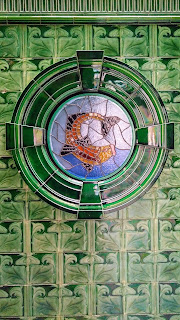Unit X Research
My group, made up of five Textiles students, one 3D designer
and one Graphic designer, have formed the group ‘Heritage Revival’. This name
reflects the ethos of the group, which focuses on the processes of traditional
crafts, whilst embracing modern technology and using it to preserve crafts for
the future.
We began by consulting the Radcliffe Red List of Endangered Crafts
and I researched marbling which I was instantly drawn to as I love working with
paper. Early on we realised that we were all keen on making and being
hands on, embracing the idea of process and wanting to retain a sense of
cohesion throughout the group. Therefore, we decided to have an overarching
theme and colour palette to tie our work together, even if we use different
processes. We felt we needed a common theme as a group because we all had contrasting ideas and practices which were at odds with one another.
 |
| Our mood board (before we cahnged the group name to Heritage Revival). |
 |
| Our group manifesto. |
One thing which we found restrictive was our original group
name, ‘Heritage Campaign’. We didn’t feel that it reflected our philosophy. We
don’t necessarily want to ‘campaign’ for heritage crafts, and felt the word was
somewhat prescriptive and more loaded than we intended. Rather, the word
‘revival’ suggested a more sensitive approach to rediscovering crafts and
embedding them in contemporary life. As a group, we want to explore heritage processes
which we can make more accessible in everyday life, whether that be through
combining old methods with new, creating objects which can be incorporated into
homes, or applied to buildings.
We chose architecture as our group theme, as it encompassed
our ideas of heritage being present around us but needing to be sensitively
preserved to remain viable into the future. To gather imagery, I took
photographs from around the city. I chose to focus on the detailing of than buildings as I was drawn to the
textures. The Victoria Baths were a great source of inspiration for surfaces, especially peeling paint, tiles and
intricate mosaics. As a group we pooled all our visual imagery to create a
group mood board. Incorporating elements of local heritage with more futuristic
architectural designs and tiles, our mood board represents an mix of inspiration forming a colour palette we feel represents
our ideas of heritage. the palette emphasises darker, brown,
blue and red tones with brighter pops of pink and yellow to include a vibrancy which represents the ideas of old and new.
 |
| Decorative inspiration from the Victoria Baths. |
The inspirer talks have provided a rich source of inspiration and I especially enjoyed Brendan Dawes' talk, where he explained how he used digital software to create his artworks. Important to him was the relationship between digital and analogue, and this reflected our group ethos. He also spoke about several collaborative projects where he has drawn on the expertise of other makers. His collaborations have helped gain a wider audience for his work, and in our group, we hope that by collaborating we can help each other overcome problems and make work which is more applicable to daily life. For example, using graphic design to influence textiles for use in the home.
I went to the workshop after Brendan Dawes’ talk, where he
showed us how to work with basic coding. I got the 3D object we coded printed,
and it was exciting to have this tangible object come from digital technology. The
helix-like form has inspired shapes which I aim to recreate through marbling.
 |
| Marbling inspiration from the Schmoller Collection of Decorative papers. |
I researched marbled papers in the Schmoller
collection in Special Collections to view handmade papers close-up and see the shapes,
textures, colours and patterns. This has inspired my own marbling and experimenting with patterns and highlighted the
importance of the hand-made process. I have been inspired by the work of
Victoria Hall and Lucy McGrath and the now closed studio Cockerell and Sons.
I plan to practice marbling using methods including
using oil paints, acrylic and shaving foam. I will challenge myself by marbling
onto materials including fabric and wood to explore new surfaces and
applications of traditional paper techniques. I want to recreate shapes
inspired by textures and details from architecture in Manchester and take the
organic shapes from marbling into 3D paper experimentation and embroidery.
 |
| Inital experiments with marbling. |





Comments
Post a Comment